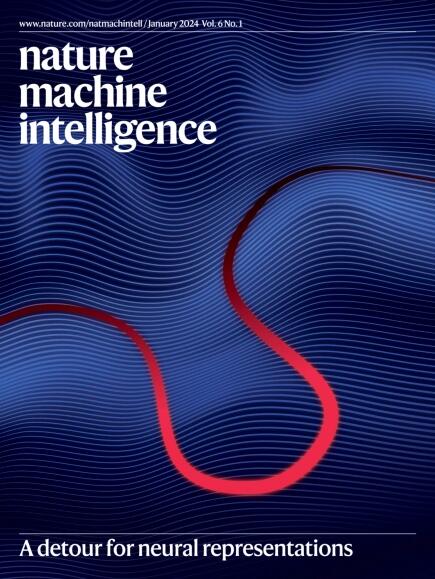Synergy-based robotic quadruped leveraging passivity for natural intelligence and behavioural diversity
IF 18.8
1区 计算机科学
Q1 COMPUTER SCIENCE, ARTIFICIAL INTELLIGENCE
引用次数: 0
Abstract
Quadrupedal animals show remarkable capabilities in traversing diverse terrains and display a range of behaviours and gait patterns. Achieving similar performance by exploiting the natural dynamics of the system is a key goal for robotics researchers. Here we show a bioinspired approach to the design of quadrupeds that seeks to exploit the body and the passive properties of the robot while maintaining active controllability on the system through minimal actuation. Utilizing an end-to-end computational design pipeline, neuromechanical couplings recorded in biological quadrupeds are translated into motor synergies, allowing minimal actuation to control the full structure via multijoint compliant mechanical couplings. Using this approach, we develop PAWS, a passive automata with synergies. By leveraging the principles of motor synergies, the design incorporates variable stiffness, anatomical insights and self-organization to simplify control while maximizing its capabilities. The resulting synergy-based quadruped requires only four actuators and exhibits emergent, animal-like dynamical responses, including passive robustness to environmental perturbations and a wide range of actuated behaviours. The finding contributes to the development of machine physical intelligence and provides robots with more efficient and natural-looking robotic locomotion by combining synergistic actuation, compliant body properties and embodied compensatory strategies. Stella, Achkar and colleagues present a bio-inspired quadruped robot that uses passive dynamics, motor synergies, variable stiffness and self-organization to achieve robust, adaptive, animal-like movement with just four actuators.


基于协同的机器人四足动物利用被动的自然智能和行为多样性
四足动物在穿越不同地形方面表现出非凡的能力,并表现出一系列的行为和步态模式。通过利用系统的自然动力学来实现类似的性能是机器人研究人员的关键目标。在这里,我们展示了一种生物启发的四足动物设计方法,旨在利用机器人的身体和被动特性,同时通过最小的驱动保持系统的主动可控性。利用端到端计算设计管道,在生物四足动物中记录的神经机械耦合被转化为运动协同作用,允许最小的驱动来控制整个结构,通过多关节柔性机械耦合。使用这种方法,我们开发了PAWS,一个具有协同作用的被动自动机。通过利用运动协同作用的原理,该设计结合了可变刚度,解剖洞察力和自组织,以简化控制,同时最大限度地发挥其功能。由此产生的基于协同的四足动物只需要四个驱动器,并表现出紧急的、类似动物的动态响应,包括对环境扰动的被动鲁棒性和广泛的驱动行为。这一发现有助于机器物理智能的发展,并通过将协同驱动、柔顺体特性和具身补偿策略相结合,为机器人提供更高效、更自然的机器人运动。
本文章由计算机程序翻译,如有差异,请以英文原文为准。
求助全文
约1分钟内获得全文
求助全文
来源期刊

Nature Machine Intelligence
Multiple-
CiteScore
36.90
自引率
2.10%
发文量
127
期刊介绍:
Nature Machine Intelligence is a distinguished publication that presents original research and reviews on various topics in machine learning, robotics, and AI. Our focus extends beyond these fields, exploring their profound impact on other scientific disciplines, as well as societal and industrial aspects. We recognize limitless possibilities wherein machine intelligence can augment human capabilities and knowledge in domains like scientific exploration, healthcare, medical diagnostics, and the creation of safe and sustainable cities, transportation, and agriculture. Simultaneously, we acknowledge the emergence of ethical, social, and legal concerns due to the rapid pace of advancements.
To foster interdisciplinary discussions on these far-reaching implications, Nature Machine Intelligence serves as a platform for dialogue facilitated through Comments, News Features, News & Views articles, and Correspondence. Our goal is to encourage a comprehensive examination of these subjects.
Similar to all Nature-branded journals, Nature Machine Intelligence operates under the guidance of a team of skilled editors. We adhere to a fair and rigorous peer-review process, ensuring high standards of copy-editing and production, swift publication, and editorial independence.
 求助内容:
求助内容: 应助结果提醒方式:
应助结果提醒方式:


